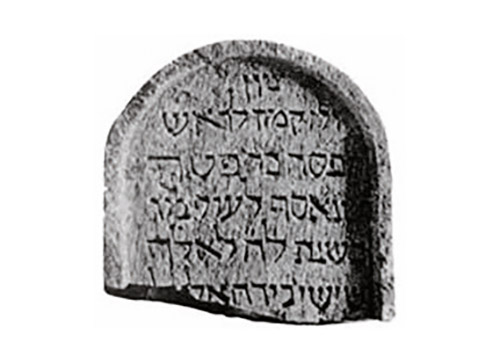


Why did these given names from medieval Ashkenazim and those from Anglia (England) fall out of favor among later Ashkenazim?
Saadiah
Gamaliel
Yosi (as in the Galilean diminutive of the Hebrew name “Yosef”)
Peter (yes, a quite common name among medieval Jews of Central Europe)
According to a passage from “Vienna” by Max Grunwald (JPS, 1936), the oldest document of the Jewish community of Vienna — which dates back to 1338 — and bears the signatures of two local Jewish notables:
“In the year 1388 … the Jews of Vienna felt grateful to the Vienna burghers that no harm befell them … They expressed their gratitude by means of a declaration that constitutes the oldest document of the Jewish community of Vienna known to us today. It is dated June 19, 1338. The document is in Hebrew and bears the signature: ‘The Kahal of Vienna (Kehal Vina)’. On the right are the names: Saadia Hayyim, son of Senior, and Moses, son of Gamaliel; on the left Hayyim, son of Eliezer.”
The name “Gamaliel” is somewhat rare among Ashkenazim, but you’ll find even latter-day Ashkenazim with this name (the charedi Rabbi, Rabbi Gamaliel Rabinowitz of Jerusalem comes to mind), but then again with the advent of chasidut, Haskalah, Zionism and the (resultant) proximity of Ashkenazic communities to virtually all other Jewish diasporas, mutual influences cannot be ruled out.
Saadia Hayyim ben Senior may have been a Sefardi who had traveled east. “Senior” is an oft-used name component in family names of the Spanish/Portuguese Jews (see, for instance, my articles in previous issues of The Jewish Link on the Senior family of Sepharad that migrated to Eastern Europe and the Near East in the post-expulsion period). “Senior” may also indicate a Loez (Proto-Yiddish) origin (much like Shprintza orEsperenza).
The name “Saadiah” is also unusual, although there was a Rabbi Saadiah Ashkenazi — who was a disciple of the Vilna Gaon. He immigrated to the land of Israel, together with other students of the Vilna Gaon, at the behest of his teacher in 1809. His gravestone was recently discovered on the Mount of Olives in Jerusalem.
Remnants of the old tombstone of Rabbi Saadiah Ashkenazi have been combined with the newly-constructed marker.
“פסח ב»ר פטר”
The earliest Jewish gravestone of Buda, Hungary, dates to 1278, and bears the name of: “Rabbi Pesach, son of Rabbi Peter.” This is not the first instance of the name; it was also the name of a Tosafist:
“«…תוס› ד»ה רבי יהודה אומר: שאל רבינו פטר לר»ת»”“Rabbenu Peter (?) asked Rabbenu Tam…” (Gittin 8a) It should be noted that both “Pesach” (or “Paseach,” if you insist) and “Shabbetai” are both biblical personal names.
“שַׁבְּתַי הַלֵּוִי, עֲזָרֻם ” (Ezra, also in Nechemia, Verse 8) “וְאֶשְׁתּוֹן, הוֹלִיד אֶת-בֵּית רָפָא וְאֶת-פָּסֵחַ” (I Chronicles, Verse 4) “יוֹיָדָע בֶּן-פָּסֵחַ” (Nehemiah, Verse 3) ”בְּנֵי פָסֵחַ“The name “Yosi” seems to have been popular in medieval England. It is interesting to note that the bulk of pre-expulsion English Jewry had migrated from France and most of the rabbis were disciples of the famed French Tosafist Rabbenu Tam, who was a grandson of the great Rashi. The name “Yosi” was a common shortened version or diminutive of “Yosef” (these diminutives seem to have been a peculiar Eretz Yisrael tradition; other examples include “Yehuda-Yudan;” “Eliezer-Lazer” et al). It has been found numerous times in the literature of the Jews of Eretz Yisrael, beginning with the Mishna, The Jerusalem Talmud and throughout various Eretz Yisrael midrashim.
Franco-German Jewry or Ashkenazim are believed to have stemmed from Italian Jewry; that diaspora in turn once maintained close links with the Jews of Eretz Yisrael (in contradistinction to the Jews of Spain and the Near East who were tied to Babylonia). While the Ashkenazim eventually adopted most of the standard normative Babylonian tradition (a preference of the Talmud Bavli over the Yerushalmi), it is important to remember that the first Jews of northern and western Europe were certainly influenced by the old traditions of Eretz Yisrael as refracted through the Italian and RomanicJewish tradition. To this day, Ashkenaz maintains customs and rituals that have its roots in Eretz Yisrael (chiefly the pronunciation of Hebrew and the use of various liturgical formulas in prayer). I would like to discuss this more in-depth in the future.
V’ein kan m’komo l’ha’arich.There are also documented cases of 14th century Polish Jews with highly “curious” names like Canaan (!) and Jordan.
From: “Trial and Achievement: Currents in Jewish History (from 313)” [by] H. H. Ben-Sasson:
“Even more remarkable are the names of Lewko’s father, Jordan, and Lewko’s son, Canaan, or Chanaan, which indicate a special devotion to Erez (sic) Israel.”
The author is the editor at Channeling Jewish History and is available to lecture. He can be reached at: [email protected].













